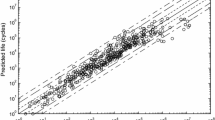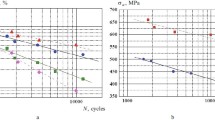Abstract
Selected methods for determining fatigue life in the strain-life approach, described by the Manson-Coffin-Basquin (MCB) equation based on results of static tensile tests are presented in this paper. These methods served for determining low-cycle characteristics for 1.2344 steel applied for dies used in forging at high temperatures. The authors presented the results of tensile tests performed at room temperature and at elevated temperatures (300 °C, 500 °C, 600 °C, and 700 °C). Data obtained from these tests enabled to theoretically determine fatigue life characteristics according to the methods: universal slope, 4-point correlation, Mitchell’s, modified universal slope method, Bäumel’s and Seeger’s method, modified 4-point-correlation method, Roessle’s and Fatemi’s method, as well as median method. Curves obtained on this basis were then compared to charts obtained from periodic deformation tests. Results obtained in this manner were compared to actual wear of tools (made of 1.2344 steel) used in the hot forging process of a cover-type forging. Fatigue tests covered deformation of specimens with uniaxial, periodically variable load until their cracking, and were performed at temperatures 20 °C, 300 °C, and 600 °C and at four levels of total strain εac: 0.5%, 0.8%, 1.0%, and 2.0%. Clear differences between the values of coefficients and exponents of the MCB equation were observed depending on the applied theoretical method and depending on test temperature. The research goal is description of different methods for determining fatigue life in strain-life approach based on results of static tensile tests and comparison them with the results from experiment. This will allow choosing the best method to predict the fatigue life of tools made of steel 1.2344 and usage of this method in the future, saving time, and costs related to the performance of experimental tests.
Similar content being viewed by others
References
Manson SS (1965) Fatigue: a complex subject – some simple approximations. Exp Mech 5(7):193–226
Socie DF, Mitchell MR, Caulfield EM (1977) Fundamentals of modern fatigue analysis, Fracture Control Program Report, No. 26, University of Illinois, USA
Muralidharan U, Manson SS (1988) Modified universal slopes equation for estimation of fatigue characteristics. J Eng Mater Technol Trans ASME 110(1):55–58
Bäumel A Jr, Seeger T (1990) Materials data for cyclic loading. Elsevier Science Publishers, Amsterdam
Ong JH (1993) An improved technique for the prediction of axial fatigue life from tensile date. Int J Fatigue 15(3):213–219
Roessle ML, Fatemi A (2000) Strain-controlled fatigue properties of steels and some simple approximations. Int J Fatigue 22(6):495–511
Meggiolaro MA, Castro JTP (2004) Statistical evaluation of strain-life fatigue crack initiation predictions. Int J Fatigue 26(5):463–476
Nieslony A, Kurek A, Ch D, Kaufmann H (2012) A study of compatibility between two classical fatigue curve models based on some selected structural materials. Int J Fatigue 39:88–94
Kim KS, Chen X, Han C, Lee HW (2002) Estimation methods for fatigue properties of steels under axial and torsional loading. Int J Fatigue 24:783–793
Marohnić T, Basan R, Franulović M (2015) Some considerations on the evaluation of methods for the estimation of fatigue parameters from monotonic properties. Procedia Eng 101:277–284
Zhang Y, Hu CL, Zhao Z, Li AP, Xu XL, Shi WB (2013) Low cycle fatigue behavior of a Cr–Mo–V matrix-type high-speed steel used for cold forging. Mater Des 44:612–621
Mrozinski S, Golanski G (2013) Elevated temperature low cycle fatigue properties of martensitic cast steel. Int J Eng Technol 13(01):86–91
Author information
Authors and Affiliations
Corresponding author
Additional information
Publisher’s note
Springer Nature remains neutral with regard to jurisdictional claims in published maps and institutional affiliations.
Rights and permissions
About this article
Cite this article
Wollmann, J., Dolny, A., Kaszuba, M. et al. Methods for determination of low-cycle properties from monotonic tensile tests of 1.2344 steel applied for hot forging dies. Int J Adv Manuf Technol 102, 3357–3367 (2019). https://doi.org/10.1007/s00170-019-03349-2
Received:
Accepted:
Published:
Issue Date:
DOI: https://doi.org/10.1007/s00170-019-03349-2




